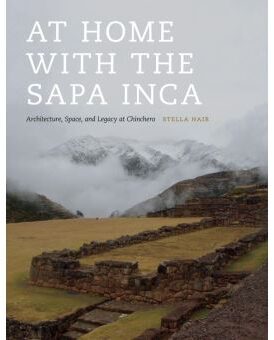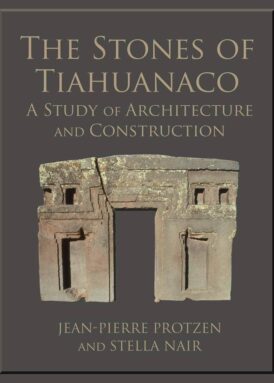Stella Nair is an Associate Professor in the Department of Art History and Core Faculty in the American Indian Studies Interdepartmental Program, the Archaeology Interdepartmental Program and the Center for 17th and 18th Century Studies at UCLA. In addition, Nair is on the Governance Board for the Center for Global Antiquity, and Affiliated Faculty with the American Indian Studies Center, the CMRS-Center for Early Global Studies, and the Latin American Institute.
Stella Nair’s scholarship focuses on the built environment of Indigenous communities in the Americas and is shaped by her interests in spatial practices, cultural landscapes, aural and ephemeral architecture, gender studies, construction technology, and hemispheric networks. Trained as an architect and architectural historian, Nair has conducted fieldwork in Bolivia, Mexico, Peru, and the United States, with ongoing projects in the South Central Andes.
Nair’s publications explore a range of subjects and regions such as Inca royal estates, colonial Andean paintings, early modern soundscapes, eighteenth century woven roofs, and Brazilian urbanism. Nair’s current book project, Inca Architecture: Chapters in the History of a (Gendered) Profession, offers new perspectives on the Inca built environment by highlighting the profound ways in which women designed, constructed, used, and gave meaning to Inca spaces and places. For this work, Nair has received the “Research Excellence Award” from the UCLA Center for the Study of Women. In addition, Nair is also working on a book with Paul Niell (co-edited), The Forgotten Canopy: Ecology, Ephemeral Architecture, and Imperialism in the Caribbean, South American, and Transatlantic World, which examines the deep and long standing architectural, ecological, and cultural connections among distinct Indigenous, African, and African descendant peoples in the Americas.
Nair’s previous book, At Home with the Sapa Inca: Architecture, Space, and Legacy at Chinchero (University of Texas, 2015), examines the sophisticated ways in which the Inca manipulated space and architecture to impose their authority. Nair has also published (with Jean-Pierre Protzen) a book entitled The Stones of Tiahuanaco: A Study of Architecture and Construction (Cotsen Institute of Archaeology Press, 2013), which explores one of the world’s most artful and sophisticated carving traditions. Nair’s article “Localizing Sacredness, Difference, and Yachacuscamcani in a Colonial Andean Painting” was honored by its selection as one of thirty-two “greatest hits” articles published in the last hundred years of the Art Bulletin.
Nair is currently a Fellow at the National Humanities Center and a Senior Fellow of Pre-Columbian Studies at Dumbarton Oaks Museum and Library (Harvard University). She is also a member of “Sound, Space, and the Aesthetic of the Sublime”, a multi-year, interdisciplinary research project funded by the Templeton Religious Trust (P.I. Jonathan Berger, Stanford University). Nair has received numerous research grants and fellowships, such as from the American Academy of Rome, the American Philosophical Association, the Center for the Study of the Visual Arts (National Gallery of Art), Dumbarton Oaks, the Fulbright Institute, the Getty Foundation, the Guggenheim Foundation, the John Carter Brown Library and the Terra Foundation for American Art.
Nair directs the Andean Laboratory and the Architecture laboratory at the Cotsen Institute of Archaeology, both of which foster research for students (graduate and undergraduate) as well as affiliated researchers working on Andean and Architectural topics at UCLA. In addition, Nair co-founded and advises three working groups on campus: the Andean Working Group, which brings together Andean specialists in the greater Los Angeles region to share research; the Architecture Working Group, which welcomes all scholars interested in architecture, especially of the Indigenous Americas and African diaspora; and with Kevin Terraciano, the Indigenous Material and Visual Culture Reading Group, which brings together students and faculty across campus who work on Indigenous material culture A.D 1450-1850.
Professor Nair is currently not accepting new graduate students.
Education
Ph.D. University of California, Berkeley (M.Arch, University of California, Berkeley)
Books
-

- At Home with the Sapa Inca: Architecture, Space, and Legacy at Chinchero
- University of Texas Press, 2015
-

- The Stones of Tiahuanaco: A Study of Architecture and Construction
- Cotsen Institute of Archaeology Press, 2013
Articles
SELECTED PUBLICATIONS
- “La tierra sagrada y la arquitectura inka,” in Los Incas, más allá de un imperio. Edited by Julio Rucabado and Cecilia Pardo. Lima: Museo de Arte de Lima (MALI) 2023 101-111.
- “Inca Architecture in Two Empires: History, Identity, and the Challenges for Historic Preservation in the Andean Built Environment.” In in-discipline: dialoghi sul patrimonio culturale, (2023): 169-188. Edited by Michele Beccu, Elisabetta Pallottino, Paola Poretta, and Francesca Romana Stabile. Rome, Italy: Universitá Roma Tre Press, Rome.
- “La plaza inca: arquitectura, paisaje, y teatro en Chinchero,” in Actas del I Congreso Internacional de Arquitectura Andina: arquitectos y arqueología, en homenaje a Emilio Harth-Terré, (2022): 159-172. Edited by Miguel Guzmán. Lima, Perú: Editorial Universitaria Universidad Ricardo Palma.
- ’Salones de vino’, conventos y otros espacios incas imaginados,” in Arte antes de la historia: para una historia del arte antiguo andino, (2020): 311-330. Edited by Marco Curratola, Cecile Murchard, Joanne Pillsbury, and Lisa Trever, Lima, Peru: Pontificia Universidad Católica del Perú.
Courses
SELECTED COURSES TAUGHT, UNDERGRADUATE
- Architecture and Feminism (seminar)
- Gender in Maya and Mexica Art (seminar)
- Art, Architecture, and Urbanism of the Americas until 1450 A.D. (lecture)
- Art, Architecture, and Urbanism of Latin America, 1450 A.D.–present (lecture)
- Art Historical Theories and Methodologies (seminar)
- Arts of the Andes (lecture)
- Cuzco: A Journey into the Urban Unknown (seminar)
- Inca Visual Culture (lecture)
- Making Sacred Landscapes: Pilgrimage in the Medieval World (lecture)
SELECTED COURSES TAUGHT, GRADUATE
- Architectural Theory and Methods: Key Thinkers and Theories
- Architecture, Space, and Landscape in Colonial Encounters (seminar)
- Art, Power, and the Sacred Capital: Tenochtitlan and Cuzco (seminar)
- Body, Gender, Place (seminar)
- Ephemerality and Architecture
- From Law of the Indies to Brasilia: Architecture and Urbanism in Latin America (Mexico, Peru, Brazil)(seminar)
- Gender, Archaeology, and Architecture (seminar)
- Materiality and Architecture
- Public Places, Private Spaces: Constructing Inca Royal Landscapes (seminar)
- The Inca in the Early Modern World (seminar)
-
Understanding Gender and Space Among the Ruins (seminar)
Selected Links
SELECTED LINKS
- Charles K. Williams II Rome Prize: Fellow Profile
- Guggenheim Fellowship: Fellow Profile
- UCLA CSW Research Excellence Award Announcement
- UCLA Faculty Newsroom: Guggenheim Fellowship Announcement
- Interview in UCLA Cotsen publication Backdirt
- Story about student collaboration in Cotsen Andean and Architecture Labs
RELATED CENTERS
- American Indian Studies Center
- Center for 17th and 18th Century Studies
- Cotsen Institute of Archaeology
- Foundation for the Advancement of Mesoamerican Studies at LACMA
- Institute of American Cultures
- Latin American Institute
- UCLA – Getty Conservation Program
LOCAL MUSEUM COLLECTIONS
- Andean Art at the Fowler Museum
- Andean Textiles at the Fowler Museum
- Maya Arts at the Los Angeles County Museum of Art
- Andean Arts at the Los Angeles County Museum of Art
- Native Arts from the Southwest Museum of the American Indian Collection
- Panamanian Art
- Art of the Ancient Americas at the Los Angeles County Museum of Art
